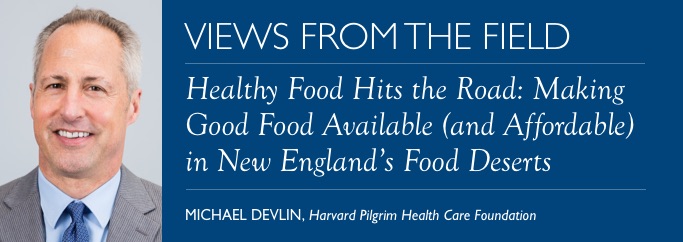
Have you ever been to an urban neighborhood and noticed that you can buy liquor, cigarettes, and junk food in abundance, but cannot find a green salad or an apple? Enter the mobile farmers’ market. In lieu of full-service supermarkets, these “veggie mobiles” have the flexibility to truly meet people where they are—and can help underserved families and communities gain greater access to fresh, healthy, local food.
Visualize an old school bus painted with bright images of fruit and vegetables, or a shiny, artistically tattooed trailer attached to a pick-up truck. Both models are used in Harvard Pilgrim Health Care Foundation’s fleet of five, grant-supported mobile farmer’s markets in New England. The mobile markets are operated by Hartford Food System in Hartford, Connecticut; Regional Environmental Council in Worcester, Massachusetts; Mill City Grows in Lowell, Massachusetts; Seacoast Eat Local in Dover, New Hampshire; and St. Mary’s Nutrition Center in Lewiston/Auburn, Maine. Mobile markets are an important part of Harvard Pilgrim’s Healthy Food Fund initiative, which started in January 2015 with the goal of increasing access to fresh, healthy, local food for families and communities across the region.
Fresh Food’s Impact in Low-Income Neighborhoods
As health care costs continue to rise, it is critical that players from every sector—public, private, and nonprofit—work collaboratively on solutions that address the health needs of low-income people and invest in preventative health measures. As the corporate philanthropy of a regional health services company, Harvard Pilgrim Foundation has a unique vantage point to view how corporate investments in the community are leading to better health.
Our Healthy Food Fund evaluation results are in and mobile farmers markets are proving to be an effective strategy in increasing access to fresh food for people in neighborhoods where it is hard to find. And it is clear that these markets are also a successful vehicle for serving low-income families. In Hartford, for example, two-thirds of all Hartford Food System’s mobile market customers are on some form of government assistance. And in Worcester, 84 percent of Worcester mobile market customers report that they consume more fruits and vegetables because the mobile market comes to their neighborhood. This fact is evidenced by their year-to-year increase in total sales from the market.
Growth of the Worcester Mobile Market (2013 – 2016)
| 2013 | 2014 | 2015* | 2016 | |
| Total Sales | $15,104 | $48,217 | $35,075 | $51,838 |
| SNAP Sales | $4,526 | $11,680 | $10,989 | $18, 502 |
| WIC/Senior Coupon Sales | $496 | $11,646 | $10,262 | $14,105 |
*Results are lower than 2014 because an additional fresh food vendor joined them in 2015 only.
Their success shows that even small organizations can improve the food environments in some of New England’s poorest communities.
Healthy Food System = Healthy Families
Harvard Pilgrim Foundation’s interest in mobile markets started in 2008, when the foundation’s President, Karen Voci, visited a mobile farmer’s market in Troy, New York, which was modeled after one in Oakland, California. At the time, she thought that the mobile markets could be a strategy to help prevent childhood obesity, which was then the foundation’s primary focus. Research showed that access to healthy food retailers are a crucial part of a healthy, vibrant food system and critical to individual health (Bell, et. al. 2013). It became clear that mobile farmer’s markets could be a solution to the challenges of food retail in underserved communities.
We brought the Executive Director of Capital Roots (formerly known as Capital District Community Gardens) to speak at a forum for nonprofit leaders in the region. In 2012, we learned that two of the organizations that attended the forum were in the midst of starting mobile markets. Harvard Pilgrim Foundation stepped in to provide small grants to each of them to see what they could do—and they took off! Based on this successful launch, we decided that this program could be expanded to other parts of our region. Now, Harvard Pilgrim supports five markets, and is seen as a leader in the region for food distribution.
Ingredients for Success
We have discovered that key factors in the success of a mobile market program are to know a community’s culture and to understand what customers want. Mill City Grows in Lowell, Massachusetts knows its client base and makes sure that ethnic vegetables are a staple of what they sell to the Cambodian and other Southeast Asian residents. The Good Food Bus in Lewiston, Maine sells easy-to-make, low-cost meal kits complete with fresh food and recipes so that customers will know how to prepare certain vegetables. The SAMM Van in Dover, New Hampshire, helps subsidize low-income customers at the end of the month when their assistance runs out.
Success also depends on supportive municipal, state, and federal policies that facilitate market operations and support use of key benefits, such as the Supplemental Nutrition Assistance Program’s Electronic Benefits Transfer (SNAP/EBT) and the Special Supplemental Nutrition Program for Women, Infants, and Children (WIC). Another key ingredient needed for a successful launch is the connection to a health care institution, most notably a hospital. Hospitals provide much-needed funds, and can also provide an automatic customer base (for example, through community health center clinics) nutrition education, health screenings, and even cooking demonstrations.
Growing Forward
Our work inspired the Massachusetts Department of Transitional Assistance to join us in hosting a regional mobile market symposium, which resulted in the department hosting an active, regional technical assistance network, or community of practice, that continues today. These sessions—on marketing, finance, and staffing—have provided an important lift for this new field, because there is no other organizing entity through which they can receive such expertise. We have seen a clear economic benefit for local farmers whose food is being sold, as well as a benefit to the local economy and our planet. And it is likely that people are becoming healthier by eating more fresh, healthy food, too. What more could the philanthropy of a health plan want?!
References
Bell, Judith, Mora, Gabriella, Hagan, Erin, Rubin, Victor, Karpyn, Allison, “Access to Healthy Food and Why It Matters: A Review of the Research,” November, 2013.

